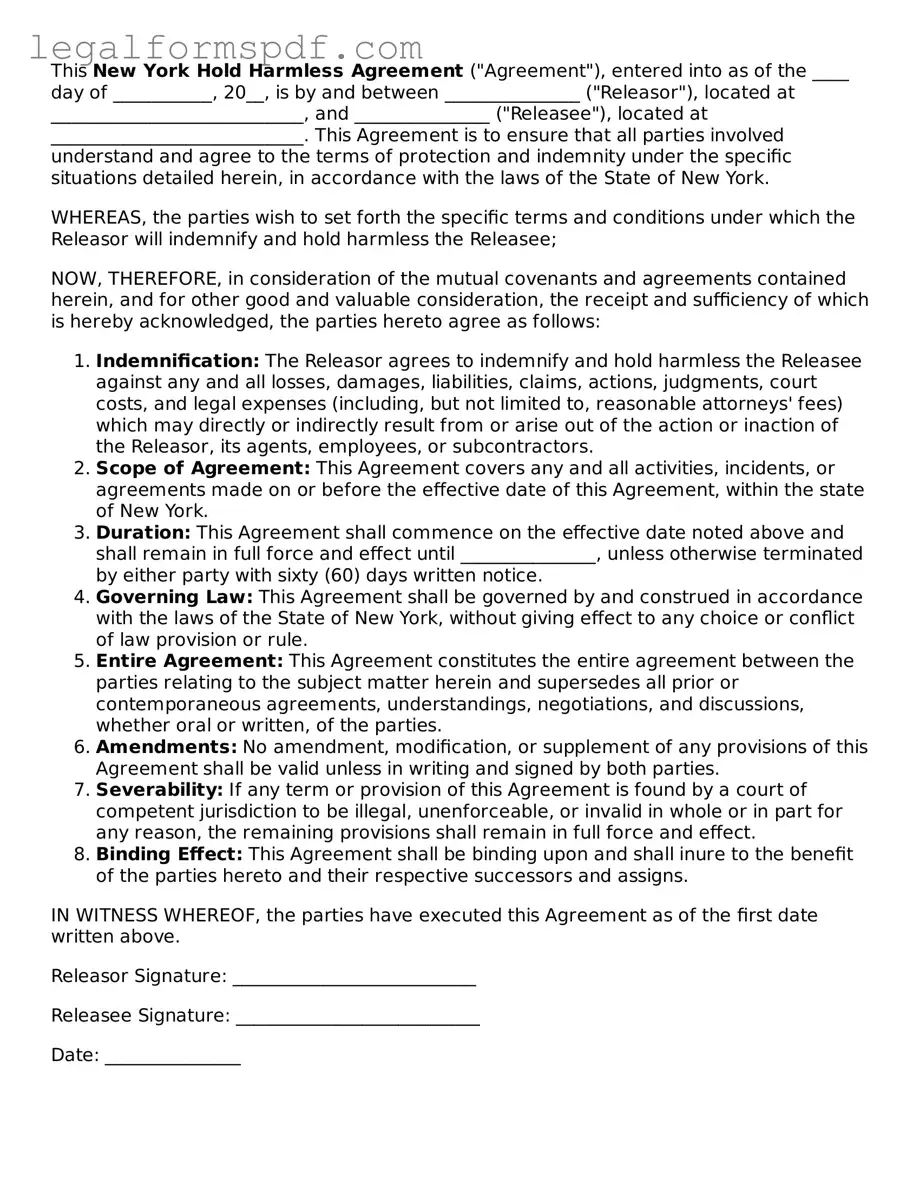What is a Hold Harmless Agreement form in New York?
A Hold Harmless Agreement in New York, also known as an indemnity agreement, is a legal document that transfers the risk from one party to another. Essentially, it ensures that one party will not hold another liable for risks, damages, or legal liabilities. These agreements are common in contracts involving a high level of risk like construction jobs, special events, or real estate rentals.
When should one use a Hold Harmless Agreement in New York?
One should use a Hold Harmless Agreement when engaging in any transaction or activity that involves a certain degree of risk. This includes, but is not limited to, construction projects, property rentals, event hosting, and any service that could potentially lead to damages or legal action. The agreement is a way to clearly define who is liable for what risks, protecting the involved parties.
Are there different types of Hold Harmless Agreements?
Yes, there are several types of Hold Harmless Agreements. They can be categorized broadly into: (1) a general hold harmless agreement, where one party agrees to not hold the other liable, (2) a mutual agreement, where both parties agree to hold each other harmless, and (3) a limited form, which specifies certain conditions under which one party will be held harmless. The type chosen depends on the specifics of the agreement and its scope.
Is a Hold Harmless Agreement legally binding in New York?
Yes, a Hold Harmless Agreement is legally binding in New York if it is executed properly. This means it must include clear language defining the scope of the indemnity, be signed by all involved parties, and, in some circumstances, be notarized. For the agreement to be enforceable, it must also involve a legal activity and the exchange of consideration (something of value).
Can a Hold Harmless Agreement be customized?
Definitely. It's important to customize a Hold Harmless Agreement to suit the specific needs and risks of the transaction or activity it covers. The more tailored the agreement, the better it can protect all parties involved. However, it's crucial to ensure that the customized terms are clear, legal, and fair to all parties to maintain its enforceability.
What are the key elements to include in a Hold Harmless Agreement?
A comprehensive Hold Harmless Agreement should include: the names of the parties involved, the date of the agreement, a detailed description of the activity or transaction, the scope of the indemnity (what risks are being transferred), any exceptions to the indemnity, the duration of the agreement, and the signature of all parties involved. Clear language is crucial to outline the responsibilities and protections.
Does a Hold Harmless Agreement remove all liability?
While a Hold Harmless Agreement can significantly limit liability for certain risks, it does not completely remove all liability. There may be legally defined limitations on what indemnity agreements can cover, especially regarding negligence or willful misconduct. It's vital to understand that these agreements cannot negate responsibility for illegal activities or override state laws that govern liability.
Can I draft a Hold Harmless Agreement myself?
While it's possible to draft a Hold Harmless Agreement on your own, it is highly advisable to consult with a legal professional. This ensures that the document is legally sound, tailored to the specific situation, and that it adequately protects your interests. An expert can also help identify any potential issues that might affect the agreement’s enforceability.
How is a Hold Harmless Agreement enforced in New York?
In New York, for a Hold Harmless Agreement to be enforced, it must be proven that the agreement is legally binding and properly executed, as mentioned earlier. In the event of a dispute, courts will analyze the document based on standard contract principles, considering the clarity of language, the fairness of the agreement, and whether it was signed by all parties involved. If the agreement is found to be valid, the courts will enforce its terms accordingly.
